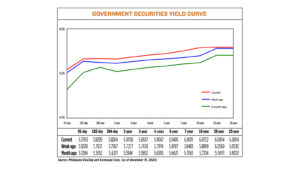Inflationary pressures may prompt pause in December — Remolona

By Luisa Maria Jacinta C. Jocson, Reporter
INFLATIONARY PRESSURES could prompt the Philippine central bank to pause its easing cycle, but a slowdown in growth may leave room for another rate cut, its governor said on Wednesday.
“Inflation pressures may cause us maybe to pause a bit, but weak growth may cause us to cut,” Bangko Sentral ng Pilipinas (BSP) Governor Eli M. Remolona, Jr. told reporters on the sidelines of an event on Wednesday.
Depending on the data, he said the Monetary Board may cut or pause at its Dec. 19 meeting.
This year, the BSP has delivered a total of 50 basis points (bps) worth of rate cuts in increments of 25-bp reductions at its August and October meetings.
“Based on our readings, there are still pressures on inflation, and the economy is also a bit weak as seen in the third quarter number,” he said in mixed English and Filipino.
Philippine gross domestic product (GDP) slowed to 5.2% in the July-to-September period from 6.4% in the second quarter and 6% a year ago.
This was also the weakest growth since the 4.3% expansion in the second quarter of last year.
In the first nine months, GDP grew by 5.8%. The economy would need to grow by at least 6.5% in the fourth quarter to meet the lower end of the government’s 6-7% target.
Mr. Remolona said November inflation is likely to remain within the 2-4% target band based on the BSP’s latest projections.
Headline inflation picked up to 2.3% in October, bringing the 10-month average to 3.3%.
The BSP’s baseline forecasts see inflation settling at 3.1% this year, 3.2% in 2025 and 3.4% in 2026.
The central bank also earlier said the balance of risks to the inflation outlook for 2025 and 2026 shifted to the upside but will likely continue to remain within target.
BSP Assistant Governor Zeno R. Abenoja said that November inflation may reflect the typhoon damage in October, but the impact from the multiple storms that hit the country in November will likely be reflected in December inflation data.
“Based on the Department of Agriculture (DA), they estimated that about 70% of the harvest was done when the typhoons started coming in, the last four typhoons,” he said.
“Hopefully, the impact will be limited, but it’s the next cycle that may be affected,” he added.
Latest data from the DA showed that the combined agriculture damage due to tropical cyclones Kristine and Leon, which made landfall in the country in late October, reached P9.81 billion.
Meanwhile, the BSP chief said that the peso’s performance is not a factor that the central bank considers in its monetary policy decisions.
“Usually, they’re different, the exchange rate and the policy rate. We don’t use the policy rate to control the exchange rate. That’s a different matter,” Mr. Remolona said.
The peso has been recently trading at the P58-per-dollar range, teetering closer to the P59 level.
Mr. Remolona earlier said he is not worried about the peso’s weakness, though the central bank has been intervening in “small amounts” following the peso depreciation amid the announcement of Donald J. Trump’s election as US President.




